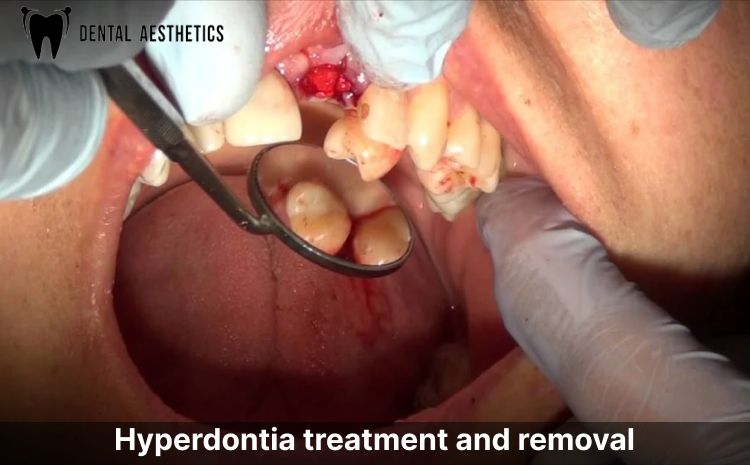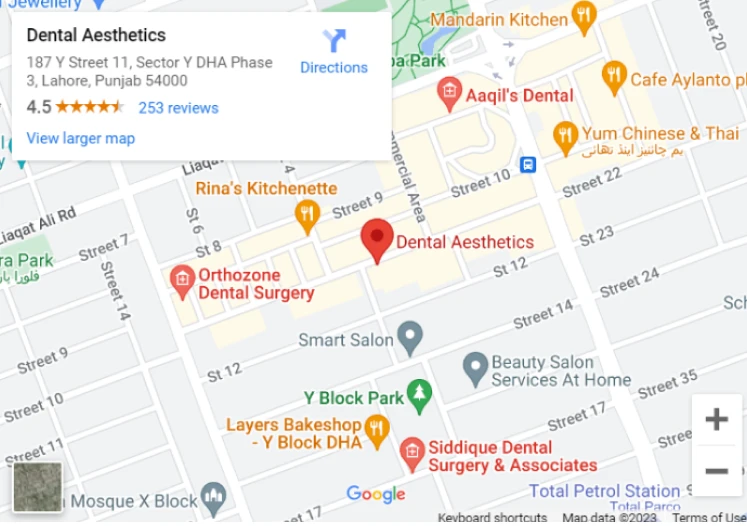What Is Hyperdontia? Types, Symptoms, and Treatment

September 25, 2025
Have you ever seen an additional tooth in your own mouth or your child's mouth, or were you concerned that a permanent tooth was taking its time? What you may be experiencing is known as hyperdontia, when additional teeth develop in the mouth above the typical number of teeth. While this may sound strange, hyperdontia is quite normal and affects both children and adults.
These extra teeth, also referred to as supernumerary teeth, exist in primary or adult dentitions, and generally, there are no adverse effects from having more teeth than normal. However, typically, extra teeth can contribute to extreme crowding of teeth, misalignment, pain, and psychological distress related to aesthetics.
At Dental Aesthetics Lahore, we frequently diagnose and effectively treat all forms of hyperdontia, no matter whether it is mild to very complex. Our advanced imaging, minimally invasive surgical techniques, and full archive of orthodontic procedures allow our patients to manage hyperdontia with little discomfort and satisfactory results.
This guide will deep dive into the information related to hyperdontia, its definition, cause, symptoms, types, and treatment, as well as how Dental Aesthetics Lahore and dental professionals can work with you and/or your child to restore confidence in their teeth.
What is Hyperdontia?
Hyperdontia is a dental condition defined by the presence of additional supernumerary teeth adjacent to the normal complement of 20 primary (baby) teeth and 32 permanent (adult) teeth. These are considered excess teeth.
Supernumerary teeth can arise anywhere in the dental arch. They may not always resemble normal teeth. Supernumerary teeth can be cone-shaped or even barrel-shaped, and some may be impacted (stuck in the bone under the gum tissue). This condition may occur in either the primary dentition or the permanent dentition.
Hyperdontia Clinical Definition
In clinical terminology, hyperdontia signifies an oral developmental abnormality with the formation of supernumerary teeth due to excess dental lamina activity. Hyperdontia occurs most frequently in the maxilla, or upper jaw, near the incisors.What Causes Hyperdontia?
The essential cause of hyperdontia is not always understood, but genetics is an important factor. Generally, hyperdontia is associated with cleidocranial dysplasia or hyperactivity of the dental lamina during development. Although the causes of Hyperdontia are not always clear, many possible contributing factors include the following:
In children, hyperdontia is often identified when a permanent tooth fails to erupt. In adults, hyperdontia is typically characterized through an X-ray or a traditional orthodontic evaluation.
| Cause | Explanation |
|---|---|
| Genetics | A family history of extra teeth increases the likelihood |
| Syndromes | When grouped with genetic conditions such as Cleidocranial Dysplasia, Hyperdontia, and Gardner’s Syndrome |
| Environmental Factors | Trauma, infection, or abnormal development of the teeth |
| Dental lamina activity | An excess of dental lamina activities during the tooth formation stage |
Types of Hyperdontia
Since hyperdontia, or supernumerary teeth, are teeth that develop in addition to normal teeth, they are characterized by both position and form.
By location:
| Type | Location |
|---|---|
| Mesiodens | Between two upper front teeth (most common) |
| Paramolar | Next to the molars |
| Distomolar | Behind the last molars |
| Peridens | Near the premolars |
By shape:
| Type | Shape |
|---|---|
| Conical | Peg-like tooth |
| Paramolar | Barrel-like if the tooth can cause eruption problems |
| Distomolar | The mass of dental tissues can be confused with a tumor |
| Supplemental | Looks like a regular tooth |
Symptoms of Hyperdontia
In many instances, hyperdontia may have no symptoms and may never be detected until dental X-rays are taken as part of a routine visit. Nonetheless, when signs occur, they can affect both function and appearance. In many cases, supernumerary (extra) teeth will affect the normal eruption of teeth, may cause crowding, or even pain. However, individuals who may be experiencing:
- Delayed eruption of permanent teeth
- Crowding or misalignment
- Jaw pain or swelling
- Impacted supernumerary teeth
- Speaking issues
- Aesthetics or appearance concerns
How is hyperdontia diagnosed?
Usually, hyperdontia is diagnosed during routine dental visits (primary dental care) or an orthodontic consultation. Because not all extra teeth will erupt into the mouth, they are frequently found incidentally on dental X-rays or 3D imaging scans.
Tools to assist in diagnosing hyperdontia are used at Dental Aesthetics Lahore:
| Method | Purpose |
|---|---|
| Panoramic X-Ray | Provides a complete view of the upper & lower jaw |
| 3D Dental Imaging | Locate impacted supernumerary teeth |
| Clinical Exam | Look for visible or erupting extra teeth |
| Orthodontic Evaluation | Evaluate spacing, alignment, and patterns of eruption |
Hyperdontia treatment and removal
The best treatment may depend on the number of teeth, the function, the location, the effects of the extra teeth on biting or chewing, the medications, etc. Here is how we treat Hyperdontia at Dental Aesthetics Lahore:
Prevention (early stages)
Currently, hyperdontia can't be prevented from arising since it is often genetically linked or linked to developmental syndromes like cleidocranial dysplasia or Gardner's syndrome. However, if it is identified early on with consistent dental visits, the impact of the hyperdontia can be significantly reduced. The way to manage it earlier is through the following:- Begin dental visits by 1 year old
- Maintain the 6-month dental visits for children, teens, and adults
- Identify patterns of eruption of both baby and adult teeth
- Speak to a dental medical professional early if the baby's teeth are delayed, or if there seems to be overcrowding of the teeth
- Although prevention is not possible, proactive management and care minimize the complications and eliminate complex treatment later for dental conditions.
Monitoring (mild cases)
For asymptomatic individuals, especially children, we may take a wait-and-see approach with regular dental appointments.Removal (extreme cases)
Extreme cases like boxing and the like may result in disfigurement of the facial appearance, extreme pain, or severe complications with teeth. The extra teeth may need to be removed if they are causing problems for the individual. We support hyperdontia removal via:- Simple extraction for erupted supernumerary teeth
- Minor oral surgery for impacted supernumerary teeth or more complex cases
- Orthodontics, to address alignment post-extraction
Cost of Hyperdontia Treatment
| Treatment | Purpose | Cost (PKR) |
|---|---|---|
| Initial consultation + X-ray | Diagnosis | 2,000–3,000 |
| Simple extraction | For a visible extra tooth | 5,000–8,000 |
| Surgical extraction | For an impacted tooth | 15,000–25,000 |
| Orthodontic treatment | To fix alignment | 80,000–150,000 (case basis) |
| Full smile makeover | Aesthetic reconstruction | Starting from 200,000 |

What are the consequences of untreated hyperdontia?
If you do not manage hyperdontia, there may be more complicated dental concerns that need restorative treatment later. Possible complications may include:
- Misalignment of the teeth that would require orthodontics
- Problems with the bite (malocclusion)
- Oral cysts or tumors that surround the impacted teeth
- Decay of the teeth and gum issues associated with the overcrowding
- Problems with speech
- Pain or discomfort in the jaw
- Concerns with aesthetics if the teeth are in the visible area
Why you should choose Dental Aesthetics Lahore for Hyperdontia treatment
Once someone has decided to actively address hyperdontia, they want precision, practical experience, and aesthetic expertise. Dental Aesthetics Lahore provides all this.
What makes us different:
- 3D dental imaging for accuracy in diagnosis
- Problems with the bite (malocclusion)
- Gentle, modern surgical techniques
- Full orthodontic support once extra teeth have been removed
- Child-friendly all-round experience
- Options for custom smile design
Conclusion
Hyperdontia may not be life-threatening, but it can be quite serious regarding its effect on your smile, self-confidence, and overall oral health. The consequences of extra teeth can affect your general oral health and quality of life if they are not treated. Cases can be mild, where there is only one extra tooth, or extreme hyperdontia cases with large amounts of teeth; either way, the answer is always early detection and expert care.
Regardless of whether it’s children's hyperdontia affecting tooth eruption on the adult teeth or hyperdontia in adults with overcrowding and bite-affecting cases, Dental Aesthetics Lahore has world-class solutions for every case. Equipped with proven, safe, and modern diagnostic tools, minimally invasive hyperdontia surgery, and a dedicated team of zealous dentists with a passion towards dental excellence, we offer same-day solutions for all our patients.
If you think you (or your child) may have extra teeth, don't wait! Contact us to book a consultation with us today, and take the first step to a healthier, more beautiful smile.
Frequently Asked Questions (FAQs about Hyperdontia)
Q1: Can hyperdontia go away on its own?
No. When extra teeth grow, they will not go away on their own. In most cases, hyperdontia surgery is needed.
Q2: Is the surgery painful?
Not at all. We will utilize local anesthetics and gentle techniques so your discomfort is minimal.
Q3: Can I get braces after my extra teeth are removed?
Absolutely! In fact, most patients often prefer to have orthodontics afterward to help realign their bite and improve the appearance of their smile.
Q4: Is hyperdontia in children common?
Yes. Hyperdontia in children is more frequent than in adults, mainly because their permanent teeth can be delayed in eruption. Therefore, identifying hyperdontia early is important to avoid misalignment and crowding of the teeth.
Q5. How do you remove excess teeth in the mouth?
Treatment of hyperdontia may consist of simply extracting the teeth that are visible or oral surgery in the case of impacted hyperdontia. At Dental Aesthetics Lahore, we have a new and painless technique that permits us to remove the extra teeth safely and effectively.
Q6: What happens if I do not treat my hyperdontia?
If hyperdontia is not treated, it can lead to overcrowding of the teeth, jaw pain, and misaligned bites; oral cysts in some cases; and, in some children, their facial symmetry may be impacted and speech development affected.
Q7: How much does hyperdontia treatment cost in Lahore?
The cost will vary based on the complexity of the case. Simple extraction starts at approximately PKR 5,000, while surgical removal and orthodontics can fall anywhere from PKR 15,000 to PKR 150,000+. After a consultation, you will receive a custom quote at Dental Aesthetics Lahore.
Q8: Is hyperdontia surgery safe for children?
Absolutely. Hyperdontia surgery for children is safe when it is carried out by a skilled and experienced dental surgeon. At Dental Aesthetics Lahore, we utilize child-friendly techniques and gentle anesthesia to ensure a comfortable experience.
Q9: How long will recovery take after hyperdontia removal?
Most patients recover from hyperdontia removal after 5-7 days. You may be advised to refrain from consuming hard foods and engage in a soft diet temporarily to assist with healing.
Q10: Will hyperdontia return after surgery?
No. After the supernumerary teeth are removed, they will not grow back. However, it is always good for your child to have regular checkups to monitor oral development.


